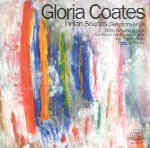I first encountered Gloria Coates’ music on a contemporary chamber concert in New York City. The work was for string quartet. At first I found the unrelenting, slow-motion glissandos utterly repellent and rather unmusical. By the work’s end I sat transfixed by the intensity and concentration governing each gesture, as if my ears had been pulled in by a magnetic field. Happily, glissando meltdowns constitute only a part of this strikingly original composer’s creative toolkit. Cette Blanche Agonie pits eerie, insect-like sustained string murmurs against a solo oboe and English horn that alternately sing, spit, rant, and spraypaint notes, while timpani and bass drum signposts interject. A high soprano intoning Mallarmé’s text hovers over the orchestra like a disembodied space traveler looking down at Mars. Similar textures characterize Symphony No. 8. Imagine that Martian surface with Southwestern Native American traditional chants and drum circles creeping out from underneath (with side coaching from Edgar Varese!) and you’ve got the idea.
The Force for Peace in War is a cantata for soprano and chamber orchestra, and it predates the composer’s glissando style. The texts intersperse wartime news bulletins with women’s poetry from the era. Coates cloaks the vocal lines in murky canvases that conjure up vivid images of sirens and smoked-out buildings. It concludes with a stirring, blatantly tonal, piano-accompanied anthem that seems stylistically alien yet proves oddly affecting. Slow-moving lines shared by strings and timpani microscopically expand and contract in Wir Tönen Allein, and do so within the larger parameters of a full orchestra and vocal quartet in Fonte di Rimini. If you listen to most of this CD in a single sitting, you’ll be hard pressed to appreciate the subtle differences between the later works. So take them in one at a time, and plan to listen without distraction. One big reason you’ll get caught up in the music has to do with the stellar performers. Featured soprano Sigune von Osten admirably copes with the composer’s frequently high tessitura and cruel demands vis-à-vis breath control. Kyle Gann’s sympathetic, impeccably detailed annotations brilliantly guide you through all the nooks and crannies of Coates’ idiosyncratic, compelling aesthetic. Hear for yourself.
































